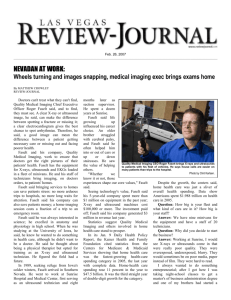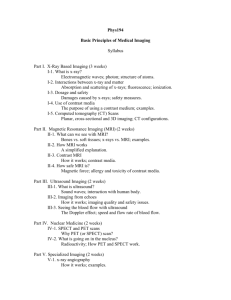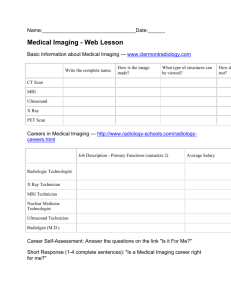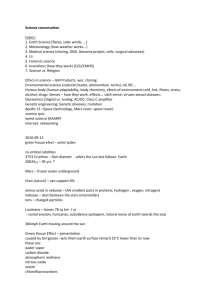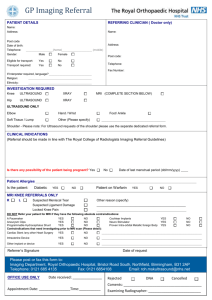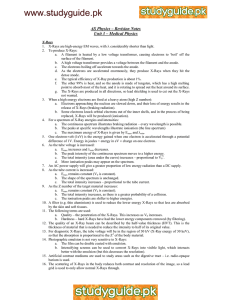Introduction to Radiology
advertisement
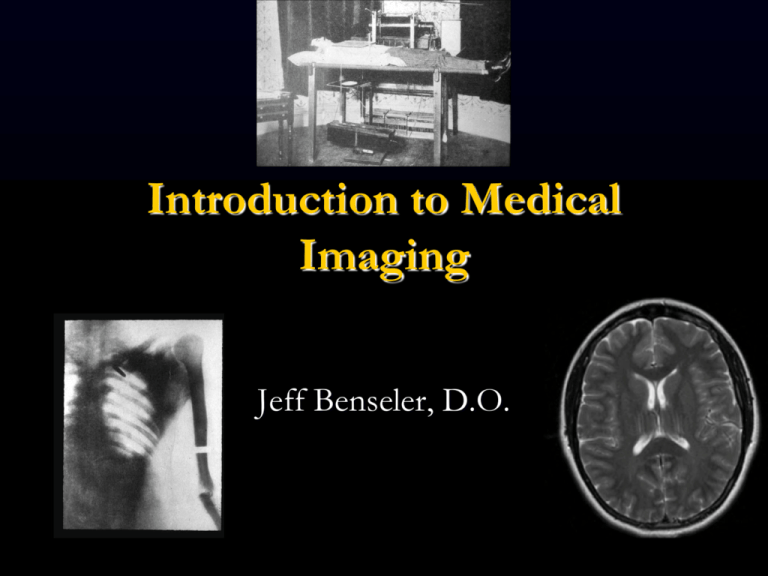
Introduction to Medical Imaging Jeff Benseler, D.O. Objectives Medical Imaging: What to expect in your first 2 years at OUHCOM Overview: How do x-rays create an image of internal body structures? What are the advantages of CT, MRI and Ultrasound? Medical Imaging (Radiology) Nearly all medical disciplines utilize medical imaging As you move from block to block we will learn: How each modality works to create an image of internal body structures Selecting the best imaging tests for a given clinical presentation Develop a stepwise repeatable pattern of evaluating medical images Method for learning medical image interpretation Most blocks will contain recorded presentations These recordings last approximately 10 to 30 minutes each Most blocks will have 2 to 4 recordings to view before the live class The recordings can be viewed and reviewed as needed anytime 24/7 In class, we will learn by interpreting unknown cases Questions about medical imaging Please feel free to contact me with questions My preferred contact method is email benseler@ohio.edu Objective 2 What are x-rays? No mass No charge Energy X-rays are a type of electromagnetic energy How do x-rays passing through the body create an image? X-rays that pass through the body render the image dark (black) X-rays that are totally blocked render the image light (white) Air = low atomic # = x-rays get through = image is dark (black) Metal = high atomic # = x-rays blocked = image is light (white) 5 Basic Radiographic Densities 1. Air Fat Soft tissue/fluid Mineral Metal 2. 3. Name these radiographic densities. 4. 5. Optimal environment for visual perception Dedicated source of light (5 to 9 mega pixel monitors) Darkened environment (like a movie theater) Limit distraction X-ray viewing station Can you recognize shapes and density? Find the pathology What clues do you have? Medical Imaging Interpretation 3 basic steps First learn how each modality creates an image of internal body structures Next, be able to accurately label normal anatomy (body structures) Then, search for structures that don’t belong and for body structures that are abnormal in size, shape, position and/or density History: 11 year old twisting injury of the foot Naming the parts of a long bone Distal 3. 2. 1. Proximal Word bank: epiphysis, metaphysis, diaphysis, cortex, medullary cavity Review: What are the 5 basic radiographic densities from black to bright white? Air Fat Soft tissue/fluid Bone/mineral Metal Summary for objective 2: How do x-rays create an image of internal body structures? X-rays pass through the body to varying degrees Higher atomic number structures block x-rays better, example bone Lower atomic number structures allow x-rays to pass through, example: air in the lungs Objective 3 Advantages of CT, MRI and Ultrasound These modalities are cross sectional imaging Cross sections are like slices X-ray studies are a 2 dimensional representation of 3 dimensional structures can result in undesirable overlapping densities and artifacts CT Advantages Eliminates overlapping densities Excellent resolution Excellent for detecting intracranial bleeding Excellent in the neck, chest and abdomen Excellent for evaluating fractures Disadvantages More expensive than xray and ultrasound Much more radiation Dense bone (petrous ridge for example) and metal cause severe artifacts air CT scan of the abdomen X-rays used skin What density is this? MRI Advantages No overlapping artifact Excellent resolution Very good at detecting fluid Excellent for imaging the brain, spine and joints No radiation Multiple imaging tests within the same study (T1, T2, IR, GE) Disadvantages Very expensive Patients cannot have a pacemaker or ferromagnetic material Slower to acquire images (approximately 45 minutes) Ultrasound Advantages No radiation Portable Instantaneous (real time) Excellent for cysts and fluid Doppler ultrasound is excellent to assess blood flow Excellent for newborn brain, thyroid, gall bladder, female pelvis, scrotum, pregnancy Disadvantages Does not work well in large or obese patients Resolution less than CT and MRI Air or bowel gas prevents visualization of structures Ultrasound of the gall bladder showing a gall stone X-rays, CT, MRI and ultrasound help us see into the body Internal body structures are composed of varied material (fat, muscle, bone, gland) or contain air, water or minerals that “show up” differently on each type of imaging test. Each modality has its own advantages allowing us the choose the best one for each medical circumstance. What an excellent medical student at your level can do: Be able to describe how x-rays can create an image of internal body structures Recognize and label the 5 basic densities on an x-ray Be familiar with the advantages for CT, for MRI and for ultrasound List of Potentially Helpful Radiology Websites http://www.med-ed.virginia.edu/courses/rad/ Online tutorial series. http://radiopaedia.org/ A free educational radiology resource with one of the web's largest collections of radiology cases and reference articles. http://www.radiologyassistant.nl/en/p42023a885587e /welcome-to-the-radiology-assistant.html Websites Continued http://learningradiology.com/index.htm Seems to have some good stuff but difficult to navigate the site. http://www.swansea-radiology.co.uk/index.html http://bubbasoft.org/ Strange name but the website is useful. Breaks it into radiologic anatomy (identification of structures) and clinical radiology (identification of pathology). Websites continued http://eradiology.bidmc.harvard.edu/index.html This source seems really valuable. Includes sections on primary care radiology, representative images of classic cases, interactive tutorials, and living anatomy http://www.radiologyeducation.com/ List of radiology resources http://www.med.wayne.edu/diagRadiology/TeachingF ile.html Collection of interesting cases Websites continued http://headneckbrainspine.com/ Neuroradiology anatomy and cases. https://3s.acr.org/CIP/Default.aspx Case in point. American College of Radiology’s case of the day.

